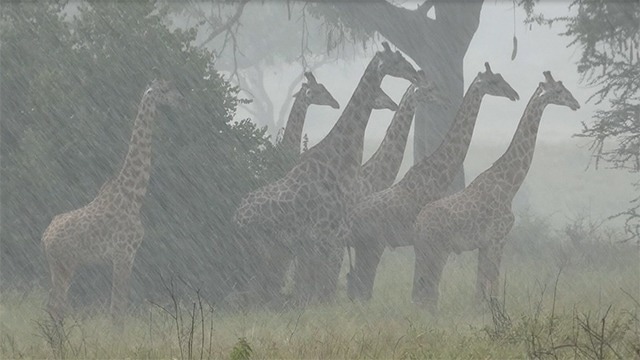Giraffes in East African savannahs are adjusting very well to increased temperatures brought on by climate change. However, scientists from the University of Zurich and Pennsylvania State University have revealed, they are under threat from increasing rainfall.
 Masai giraffes in Tanzania have lower survival during seasons of heavier rainfall, which is predicted to increase under climate change. Image Credit: Derek Lee.
Masai giraffes in Tanzania have lower survival during seasons of heavier rainfall, which is predicted to increase under climate change. Image Credit: Derek Lee.
Climate change is expected to cause massive population declines in wildlife around the planet. However, very little was previously known about the combined impact of climate change and human activities on the survival rates of large African herbivore species, including giraffes.
Scientists from the University of Zurich and Pennsylvania State University have completed a decade-long study of a giraffe population in Tanzania’s Tarangire region, the largest to date. The study area covered over a thousand square kilometers and included regions both inside and outside of protected areas.
Contrary to popular belief, greater temperatures were found to benefit adult giraffe survival, while rainier wet seasons affected adult and calf survival.
First Exploration into the Effects of Climate Variation on Giraffe Survival
The research team, headed by Monica Bond, a Postdoctoral Research Associate in the Department of Evolutionary Biology and Environmental Studies at the University of Zurich, assessed the impact of local anomalies in temperature, rainfall, and vegetation greenness on giraffe survival. They also investigated if the climate had a higher impact on giraffes near the borders of protected reserves, which were also impacted by human activities.
Studying the effects of climate and human pressures on a long-lived and slow-breeding animal like a giraffe requires monitoring their populations over a lengthy time period and over a large area, enough to capture both climate variation and any immediate or delayed effects on survival.
Monica Bond, Postdoctoral Research Associate, Department of Evolutionary Biology and Environmental Studies, University of Zurich
The researchers collected nearly two decades of data on local rainfall, vegetation greenness, and temperature during Tanzania’s short rains, long rains, and dry seasons. Then they tracked the movements of 2,385 individually identified giraffes of all ages and sexes over the last eight years of the two-decade period.
Surprising Effects of Temperature on Giraffe Survival
The researchers assumed that higher temperatures would affect adult giraffes because their large body size would cause them to overheat, yet they discovered that higher temperatures helped adult giraffes survive.
The giraffe has several physical features that help it to keep cool, like a long neck and legs for evaporative heat loss, specialized nasal cavities, an intricate network of arteries that supply blood to the brain, and spot patches which radiate heat.
Derek Lee, Study Senior Author and Associate Research Professor, Biology, Pennsylvania State University
Lee also adds, “Temperatures during our study period may not have exceeded the tolerable thermal range for giraffes, and an extreme heat wave in the future might reveal a threshold above which these massive animals might be harmed.”
Heavy Rains May Increase Parasites While Reducing the Nutritional Value of Vegetation
The survival of giraffe adults and calves dropped during rainy seasons, which the scientists attributed to increased parasites and disease.
An earlier study in the Tarangire region identified that the intensity of gastrointestinal parasites in giraffes was higher during the rainy season than during the dry season, and heavy flooding has caused significant outbreaks of diseases proven to cause mortality in giraffes, like Rift Valley fever virus and anthrax.
The present research also showed that higher vegetation greenness lowered adult giraffe survival since faster leaf growth decreases nutrient quality in giraffe food.
Human Pressure Places Additional Stress on Already Declining Populations
Climate impacts were amplified by the giraffes’ closeness to the edge of protected reserves, but not during every season.
Our findings indicate that giraffes living near the peripheries of the protected areas are most vulnerable during heavy short rains. These conditions likely heighten disease risks associated with livestock, and muddy terrain hampers anti-poaching patrols, leading to increased threats to giraffe survival.
Arpat Ozgul, Professor and Study Author, University of Zurich
The group concluded that projected climate changes in East Africa, such as heavier rainfall during short rains, will likely endanger the existence of giraffes in one of the world’s most important landscapes for large mammals, highlighting the need for effective land-use planning and anti-poaching to enhance giraffes’ resilience to the coming changes.
Journal Reference:
Bond, M. L., et al. (2023). Effect of local climate anomalies on giraffe survival. Biodiversity and Conservation. doi.org/10.1007/s10531-023-02645-4.